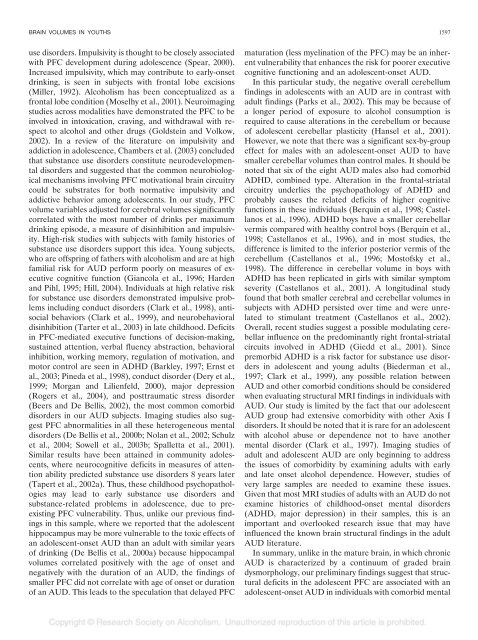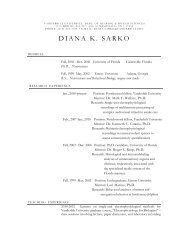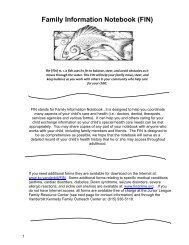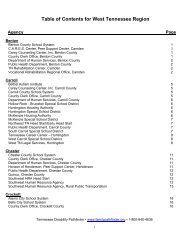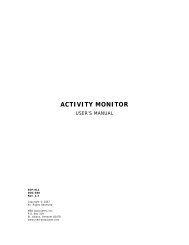Prefrontal Cortex, Thalamus, and Cerebellar Volumes in ...
Prefrontal Cortex, Thalamus, and Cerebellar Volumes in ...
Prefrontal Cortex, Thalamus, and Cerebellar Volumes in ...
You also want an ePaper? Increase the reach of your titles
YUMPU automatically turns print PDFs into web optimized ePapers that Google loves.
BRAIN VOLUMES IN YOUTHS 1597<br />
use disorders. Impulsivity is thought to be closely associated<br />
with PFC development dur<strong>in</strong>g adolescence (Spear, 2000).<br />
Increased impulsivity, which may contribute to early-onset<br />
dr<strong>in</strong>k<strong>in</strong>g, is seen <strong>in</strong> subjects with frontal lobe excisions<br />
(Miller, 1992). Alcoholism has been conceptualized as a<br />
frontal lobe condition (Moselhy et al., 2001). Neuroimag<strong>in</strong>g<br />
studies across modalities have demonstrated the PFC to be<br />
<strong>in</strong>volved <strong>in</strong> <strong>in</strong>toxication, crav<strong>in</strong>g, <strong>and</strong> withdrawal with respect<br />
to alcohol <strong>and</strong> other drugs (Goldste<strong>in</strong> <strong>and</strong> Volkow,<br />
2002). In a review of the literature on impulsivity <strong>and</strong><br />
addiction <strong>in</strong> adolescence, Chambers et al. (2003) concluded<br />
that substance use disorders constitute neurodevelopmental<br />
disorders <strong>and</strong> suggested that the common neurobiological<br />
mechanisms <strong>in</strong>volv<strong>in</strong>g PFC motivational bra<strong>in</strong> circuitry<br />
could be substrates for both normative impulsivity <strong>and</strong><br />
addictive behavior among adolescents. In our study, PFC<br />
volume variables adjusted for cerebral volumes significantly<br />
correlated with the most number of dr<strong>in</strong>ks per maximum<br />
dr<strong>in</strong>k<strong>in</strong>g episode, a measure of dis<strong>in</strong>hibition <strong>and</strong> impulsivity.<br />
High-risk studies with subjects with family histories of<br />
substance use disorders support this idea. Young subjects,<br />
who are offspr<strong>in</strong>g of fathers with alcoholism <strong>and</strong> are at high<br />
familial risk for AUD perform poorly on measures of executive<br />
cognitive function (Giancola et al., 1996; Harden<br />
<strong>and</strong> Pihl, 1995; Hill, 2004). Individuals at high relative risk<br />
for substance use disorders demonstrated impulsive problems<br />
<strong>in</strong>clud<strong>in</strong>g conduct disorders (Clark et al., 1998), antisocial<br />
behaviors (Clark et al., 1999), <strong>and</strong> neurobehavioral<br />
dis<strong>in</strong>hibition (Tarter et al., 2003) <strong>in</strong> late childhood. Deficits<br />
<strong>in</strong> PFC-mediated executive functions of decision-mak<strong>in</strong>g,<br />
susta<strong>in</strong>ed attention, verbal fluency abstraction, behavioral<br />
<strong>in</strong>hibition, work<strong>in</strong>g memory, regulation of motivation, <strong>and</strong><br />
motor control are seen <strong>in</strong> ADHD (Barkley, 1997; Ernst et<br />
al., 2003; P<strong>in</strong>eda et al., 1998), conduct disorder (Dery et al.,<br />
1999; Morgan <strong>and</strong> Lilienfeld, 2000), major depression<br />
(Rogers et al., 2004), <strong>and</strong> posttraumatic stress disorder<br />
(Beers <strong>and</strong> De Bellis, 2002), the most common comorbid<br />
disorders <strong>in</strong> our AUD subjects. Imag<strong>in</strong>g studies also suggest<br />
PFC abnormalities <strong>in</strong> all these heterogeneous mental<br />
disorders (De Bellis et al., 2000b; Nolan et al., 2002; Schulz<br />
et al., 2004; Sowell et al., 2003b; Spalletta et al., 2001).<br />
Similar results have been atta<strong>in</strong>ed <strong>in</strong> community adolescents,<br />
where neurocognitive deficits <strong>in</strong> measures of attention<br />
ability predicted substance use disorders 8 years later<br />
(Tapert et al., 2002a). Thus, these childhood psychopathologies<br />
may lead to early substance use disorders <strong>and</strong><br />
substance-related problems <strong>in</strong> adolescence, due to preexist<strong>in</strong>g<br />
PFC vulnerability. Thus, unlike our previous f<strong>in</strong>d<strong>in</strong>gs<br />
<strong>in</strong> this sample, where we reported that the adolescent<br />
hippocampus may be more vulnerable to the toxic effects of<br />
an adolescent-onset AUD than an adult with similar years<br />
of dr<strong>in</strong>k<strong>in</strong>g (De Bellis et al., 2000a) because hippocampal<br />
volumes correlated positively with the age of onset <strong>and</strong><br />
negatively with the duration of an AUD, the f<strong>in</strong>d<strong>in</strong>gs of<br />
smaller PFC did not correlate with age of onset or duration<br />
of an AUD. This leads to the speculation that delayed PFC<br />
maturation (less myel<strong>in</strong>ation of the PFC) may be an <strong>in</strong>herent<br />
vulnerability that enhances the risk for poorer executive<br />
cognitive function<strong>in</strong>g <strong>and</strong> an adolescent-onset AUD.<br />
In this particular study, the negative overall cerebellum<br />
f<strong>in</strong>d<strong>in</strong>gs <strong>in</strong> adolescents with an AUD are <strong>in</strong> contrast with<br />
adult f<strong>in</strong>d<strong>in</strong>gs (Parks et al., 2002). This may be because of<br />
a longer period of exposure to alcohol consumption is<br />
required to cause alterations <strong>in</strong> the cerebellum or because<br />
of adolescent cerebellar plasticity (Hansel et al., 2001).<br />
However, we note that there was a significant sex-by-group<br />
effect for males with an adolescent-onset AUD to have<br />
smaller cerebellar volumes than control males. It should be<br />
noted that six of the eight AUD males also had comorbid<br />
ADHD, comb<strong>in</strong>ed type. Alteration <strong>in</strong> the frontal-striatal<br />
circuitry underlies the psychopathology of ADHD <strong>and</strong><br />
probably causes the related deficits of higher cognitive<br />
functions <strong>in</strong> these <strong>in</strong>dividuals (Berqu<strong>in</strong> et al., 1998; Castellanos<br />
et al., 1996). ADHD boys have a smaller cerebellar<br />
vermis compared with healthy control boys (Berqu<strong>in</strong> et al.,<br />
1998; Castellanos et al., 1996), <strong>and</strong> <strong>in</strong> most studies, the<br />
difference is limited to the <strong>in</strong>ferior posterior vermis of the<br />
cerebellum (Castellanos et al., 1996; Mostofsky et al.,<br />
1998). The difference <strong>in</strong> cerebellar volume <strong>in</strong> boys with<br />
ADHD has been replicated <strong>in</strong> girls with similar symptom<br />
severity (Castellanos et al., 2001). A longitud<strong>in</strong>al study<br />
found that both smaller cerebral <strong>and</strong> cerebellar volumes <strong>in</strong><br />
subjects with ADHD persisted over time <strong>and</strong> were unrelated<br />
to stimulant treatment (Castellanos et al., 2002).<br />
Overall, recent studies suggest a possible modulat<strong>in</strong>g cerebellar<br />
<strong>in</strong>fluence on the predom<strong>in</strong>antly right frontal-striatal<br />
circuits <strong>in</strong>volved <strong>in</strong> ADHD (Giedd et al., 2001). S<strong>in</strong>ce<br />
premorbid ADHD is a risk factor for substance use disorders<br />
<strong>in</strong> adolescent <strong>and</strong> young adults (Biederman et al.,<br />
1997; Clark et al., 1999), any possible relation between<br />
AUD <strong>and</strong> other comorbid conditions should be considered<br />
when evaluat<strong>in</strong>g structural MRI f<strong>in</strong>d<strong>in</strong>gs <strong>in</strong> <strong>in</strong>dividuals with<br />
AUD. Our study is limited by the fact that our adolescent<br />
AUD group had extensive comorbidity with other Axis I<br />
disorders. It should be noted that it is rare for an adolescent<br />
with alcohol abuse or dependence not to have another<br />
mental disorder (Clark et al., 1997). Imag<strong>in</strong>g studies of<br />
adult <strong>and</strong> adolescent AUD are only beg<strong>in</strong>n<strong>in</strong>g to address<br />
the issues of comorbidity by exam<strong>in</strong><strong>in</strong>g adults with early<br />
<strong>and</strong> late onset alcohol dependence. However, studies of<br />
very large samples are needed to exam<strong>in</strong>e these issues.<br />
Given that most MRI studies of adults with an AUD do not<br />
exam<strong>in</strong>e histories of childhood-onset mental disorders<br />
(ADHD, major depression) <strong>in</strong> their samples, this is an<br />
important <strong>and</strong> overlooked research issue that may have<br />
<strong>in</strong>fluenced the known bra<strong>in</strong> structural f<strong>in</strong>d<strong>in</strong>gs <strong>in</strong> the adult<br />
AUD literature.<br />
In summary, unlike <strong>in</strong> the mature bra<strong>in</strong>, <strong>in</strong> which chronic<br />
AUD is characterized by a cont<strong>in</strong>uum of graded bra<strong>in</strong><br />
dysmorphology, our prelim<strong>in</strong>ary f<strong>in</strong>d<strong>in</strong>gs suggest that structural<br />
deficits <strong>in</strong> the adolescent PFC are associated with an<br />
adolescent-onset AUD <strong>in</strong> <strong>in</strong>dividuals with comorbid mental


